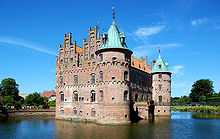Egeskov Castle
Egeskov Castle [ ˈeːəsgɔu̯ʔ ] is a moated castle in Kværndrup on the island of Funen in Denmark .
The still medieval-themed building was transformed throughout its history from an externally late Gothic , already inside the style of the Renaissance designed Wasserburg in a homely country castle. The building is surrounded by extensive gardens (according to the owners the largest historical garden in Denmark) and there are several museums on the castle grounds.
history
The castle was built by the Reichsmarschall Frands Brockenhuus (1518–1569) and completed in 1554. In 1545 he married Anne Tinhuus, who had taken over the original farm from her parents. The political unrest, the Reformation and the civil war from 1534 to 1536 caused many large landowners of that time to build their residence as a fortress that was difficult to conquer . So also Frands Brockenhuus, who built his castle in the middle of a lake, according to tradition on a foundation on so many oak stakes that “a whole oak forest was lost”. Hence the name Egeskov (oak forest).
Until 1784 Egeskov was passed on to the descendants of Brockenhuus, including Corfitz Ulfeldt and his brothers through their mother Anne Brockenhuus. In 1784 the privy councilor and bailiff Henrik Bille-Brahe (1709–1789) bought the castle. He came from the noble family of Bille and had acquired the patent of the extinct noble family Brahe in 1787. Egeskov Castle remained in the possession of the Bille-Brahe family until 1882. Then Julius Ahlefeldt- Laurvig-Bille took over the castle. He commissioned the Swedish architect Helgo Zettervall to renovate the building. He raised the spiers, restored the previous stepped gables and built the gateway. The castle still belongs to his descendants, the liege counts Ahlefeldt-Laurvig-Bille. In 1986 it was opened to tourism.
Museums
Castle Museum
The most important part of the museum complex is the Renaissance castle itself. There are around ten splendid rooms on two floors and an exhibition area in the attic. A large number of exotic hunting trophies testify to the hunting passion of a former lord of the castle. Furniture, paintings, musical instruments, porcelain and many other art objects document the long history of the house, which is now owned by Count Michael Ahlefeldt- Laurvig-Bille.
Titanias Palace
The most famous exhibit of the museum is the very large dolls house "Titanias Palast", named after the elf queen Titania. The English officer Sir Neville Wilkinson worked on this unique work of art for more than 15 years. The room-sized palace consists of over 3,000 parts with great attention to detail and some of it itself contains valuable art treasures. Among the miniature rooms of the palace is z. B. a chapel with a playable organ.
Other museums

In the outbuildings there are several other museums, including exhibitions of automobiles (vintage cars up to the 1970s), airplanes and motorcycles, a museum on the history of rescue services in Denmark and an exhibition of dolls houses. Further exhibitions deal with the history of agriculture, trade and handicrafts.
The legend of the wooden man
In the attic of the stair tower is a wooden figure that used to adorn a hall of the castle. According to the legend, it must never be removed from its place and a new bed of straw must be prepared for each Christmas, otherwise Egeskov will sink into the ditch on Christmas night.
The garden
The gardens surrounding the castle lake were created at different times and have been expanded again and again in the present and adapted to tourist expectations. A formal garden area opposite the castle was reconstructed as early as the 1950s.
In the northeast part, which is not open to the public, there is a historical maze of hornbeam hedges , the pattern of which largely corresponds to the famous facility at Hampton Court Palace ; its origin is dated to the year 1733. A greatly enlarged and somewhat expanded replanting, designed by the multi-artist Piet Hein , is located southeast of the Burgsee, as are two other modern garden labyrinths.
In 2012 the garden received the “European Garden Prize” of the European Garden Heritage Network in the category “Further development of historical facilities”.
See also
List of castles, chateaus and mansions in Denmark
Web links
- German homepage. In: egeskov.dk.
- Thomas Soltau: Ancient amusement park at Egeskov Castle. In: merian.de.
Individual evidence
- ↑ The story of Egeskov. In: egeskov.dk. Retrieved February 15, 2020 .
Coordinates: 55 ° 10 ′ 35 ″ N , 10 ° 29 ′ 22 ″ E



